Comprehensive Report: Financial Reporting Conceptual Framework
VerifiedAdded on 2021/04/16
|14
|3107
|46
Report
AI Summary
This report provides a detailed analysis of the conceptual framework for financial reporting. It begins by outlining the objectives of financial reporting and the underlying assumptions of the framework, including the going concern and accrual bases. The report then delves into the qualitative characteristics, both fundamental (relevance and faithful representation) and enhancing (comparability, verifiability, timeliness, and understandability). Furthermore, it identifies the key elements of financial statements (assets, liabilities, equity, income, and expenses) and discusses the concepts of capital and capital maintenance, including financial and physical capital maintenance. Finally, the report examines the use of fair value and historical cost in the preparation and presentation of financial statements, providing a comprehensive overview of the framework's key components and their implications from a business perspective.
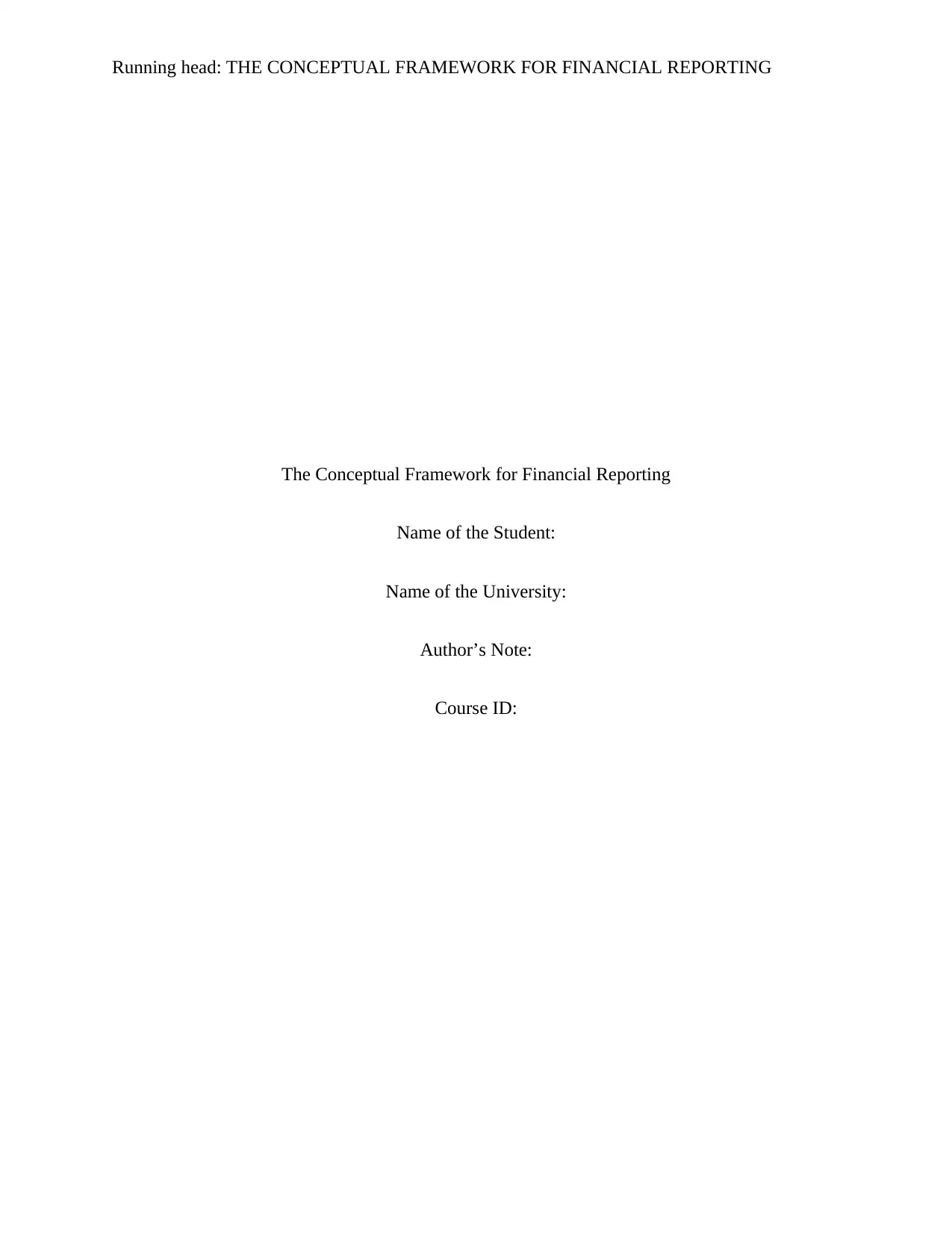
Running head: THE CONCEPTUAL FRAMEWORK FOR FINANCIAL REPORTING
The Conceptual Framework for Financial Reporting
Name of the Student:
Name of the University:
Author’s Note:
Course ID:
The Conceptual Framework for Financial Reporting
Name of the Student:
Name of the University:
Author’s Note:
Course ID:
Paraphrase This Document
Need a fresh take? Get an instant paraphrase of this document with our AI Paraphraser
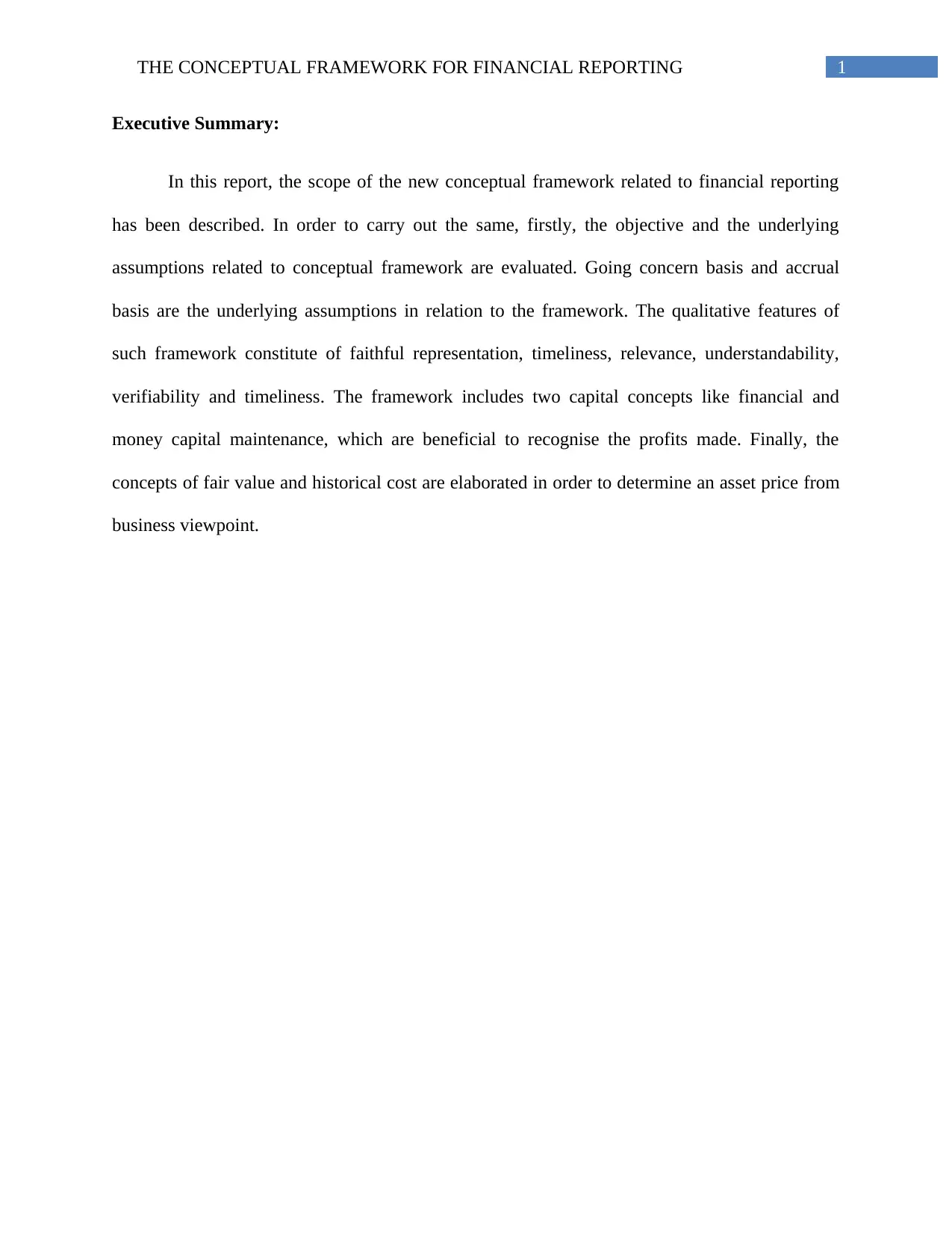
1THE CONCEPTUAL FRAMEWORK FOR FINANCIAL REPORTING
Executive Summary:
In this report, the scope of the new conceptual framework related to financial reporting
has been described. In order to carry out the same, firstly, the objective and the underlying
assumptions related to conceptual framework are evaluated. Going concern basis and accrual
basis are the underlying assumptions in relation to the framework. The qualitative features of
such framework constitute of faithful representation, timeliness, relevance, understandability,
verifiability and timeliness. The framework includes two capital concepts like financial and
money capital maintenance, which are beneficial to recognise the profits made. Finally, the
concepts of fair value and historical cost are elaborated in order to determine an asset price from
business viewpoint.
Executive Summary:
In this report, the scope of the new conceptual framework related to financial reporting
has been described. In order to carry out the same, firstly, the objective and the underlying
assumptions related to conceptual framework are evaluated. Going concern basis and accrual
basis are the underlying assumptions in relation to the framework. The qualitative features of
such framework constitute of faithful representation, timeliness, relevance, understandability,
verifiability and timeliness. The framework includes two capital concepts like financial and
money capital maintenance, which are beneficial to recognise the profits made. Finally, the
concepts of fair value and historical cost are elaborated in order to determine an asset price from
business viewpoint.
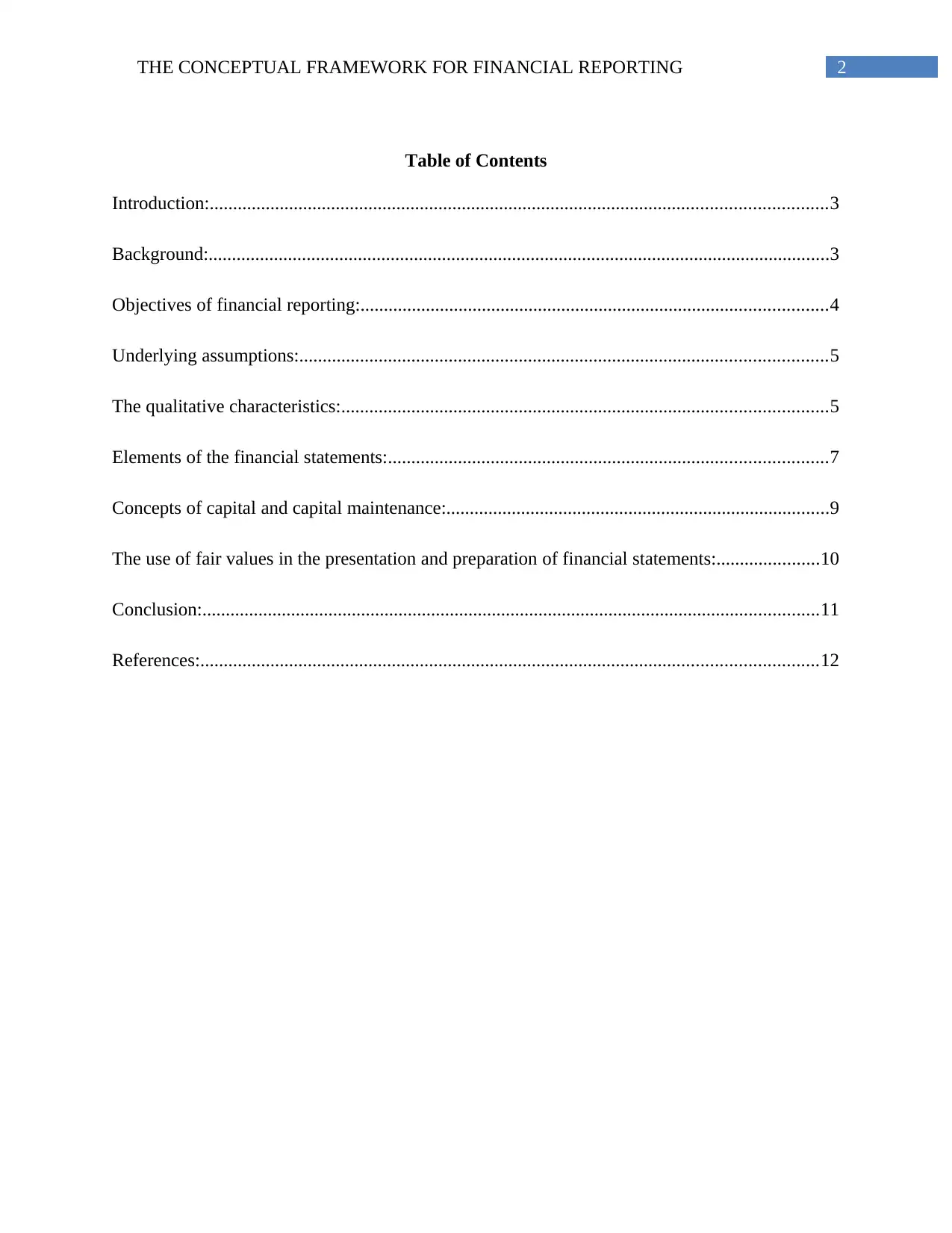
2THE CONCEPTUAL FRAMEWORK FOR FINANCIAL REPORTING
Table of Contents
Introduction:....................................................................................................................................3
Background:.....................................................................................................................................3
Objectives of financial reporting:....................................................................................................4
Underlying assumptions:.................................................................................................................5
The qualitative characteristics:........................................................................................................5
Elements of the financial statements:..............................................................................................7
Concepts of capital and capital maintenance:..................................................................................9
The use of fair values in the presentation and preparation of financial statements:......................10
Conclusion:....................................................................................................................................11
References:....................................................................................................................................12
Table of Contents
Introduction:....................................................................................................................................3
Background:.....................................................................................................................................3
Objectives of financial reporting:....................................................................................................4
Underlying assumptions:.................................................................................................................5
The qualitative characteristics:........................................................................................................5
Elements of the financial statements:..............................................................................................7
Concepts of capital and capital maintenance:..................................................................................9
The use of fair values in the presentation and preparation of financial statements:......................10
Conclusion:....................................................................................................................................11
References:....................................................................................................................................12
⊘ This is a preview!⊘
Do you want full access?
Subscribe today to unlock all pages.

Trusted by 1+ million students worldwide
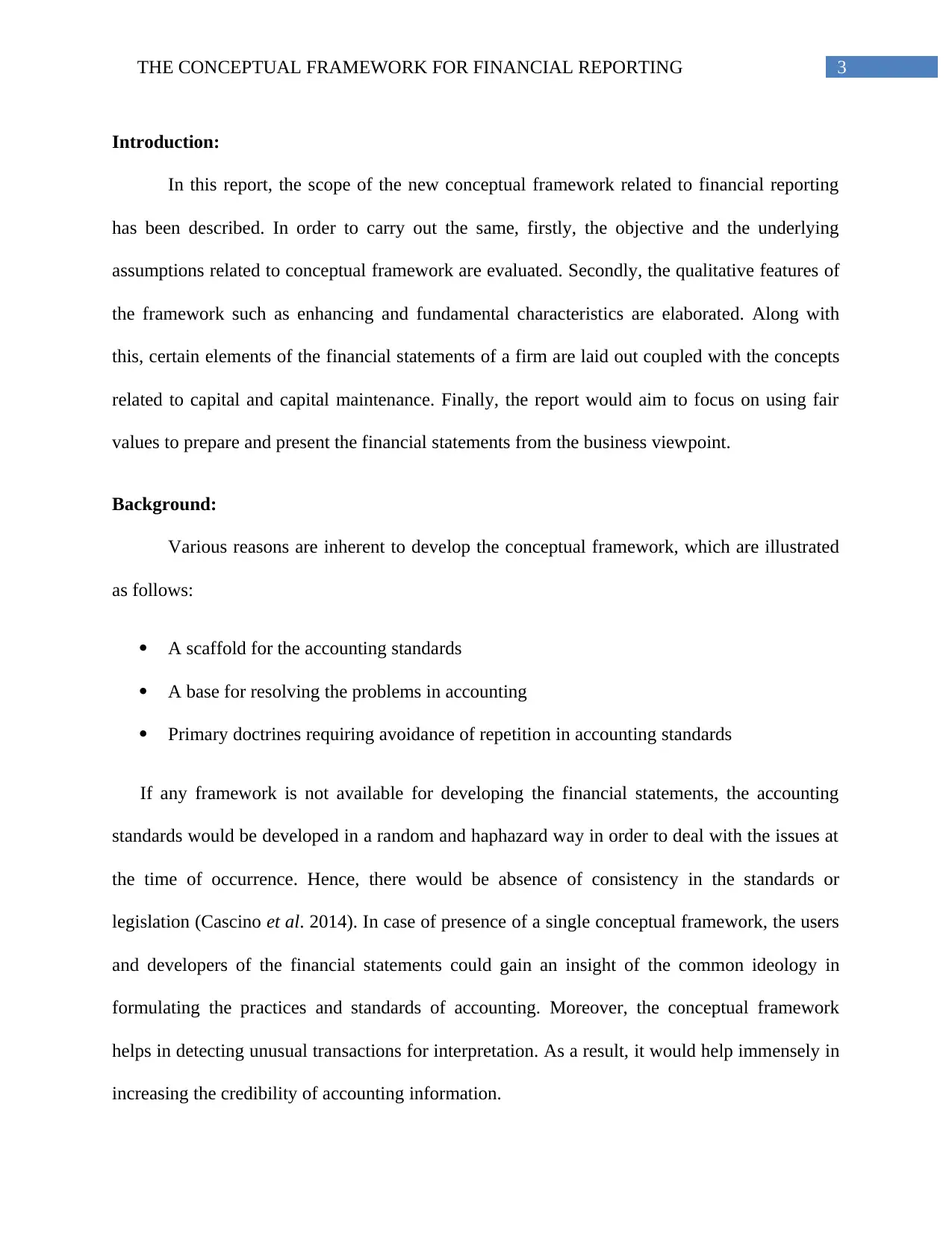
3THE CONCEPTUAL FRAMEWORK FOR FINANCIAL REPORTING
Introduction:
In this report, the scope of the new conceptual framework related to financial reporting
has been described. In order to carry out the same, firstly, the objective and the underlying
assumptions related to conceptual framework are evaluated. Secondly, the qualitative features of
the framework such as enhancing and fundamental characteristics are elaborated. Along with
this, certain elements of the financial statements of a firm are laid out coupled with the concepts
related to capital and capital maintenance. Finally, the report would aim to focus on using fair
values to prepare and present the financial statements from the business viewpoint.
Background:
Various reasons are inherent to develop the conceptual framework, which are illustrated
as follows:
A scaffold for the accounting standards
A base for resolving the problems in accounting
Primary doctrines requiring avoidance of repetition in accounting standards
If any framework is not available for developing the financial statements, the accounting
standards would be developed in a random and haphazard way in order to deal with the issues at
the time of occurrence. Hence, there would be absence of consistency in the standards or
legislation (Cascino et al. 2014). In case of presence of a single conceptual framework, the users
and developers of the financial statements could gain an insight of the common ideology in
formulating the practices and standards of accounting. Moreover, the conceptual framework
helps in detecting unusual transactions for interpretation. As a result, it would help immensely in
increasing the credibility of accounting information.
Introduction:
In this report, the scope of the new conceptual framework related to financial reporting
has been described. In order to carry out the same, firstly, the objective and the underlying
assumptions related to conceptual framework are evaluated. Secondly, the qualitative features of
the framework such as enhancing and fundamental characteristics are elaborated. Along with
this, certain elements of the financial statements of a firm are laid out coupled with the concepts
related to capital and capital maintenance. Finally, the report would aim to focus on using fair
values to prepare and present the financial statements from the business viewpoint.
Background:
Various reasons are inherent to develop the conceptual framework, which are illustrated
as follows:
A scaffold for the accounting standards
A base for resolving the problems in accounting
Primary doctrines requiring avoidance of repetition in accounting standards
If any framework is not available for developing the financial statements, the accounting
standards would be developed in a random and haphazard way in order to deal with the issues at
the time of occurrence. Hence, there would be absence of consistency in the standards or
legislation (Cascino et al. 2014). In case of presence of a single conceptual framework, the users
and developers of the financial statements could gain an insight of the common ideology in
formulating the practices and standards of accounting. Moreover, the conceptual framework
helps in detecting unusual transactions for interpretation. As a result, it would help immensely in
increasing the credibility of accounting information.
Paraphrase This Document
Need a fresh take? Get an instant paraphrase of this document with our AI Paraphraser
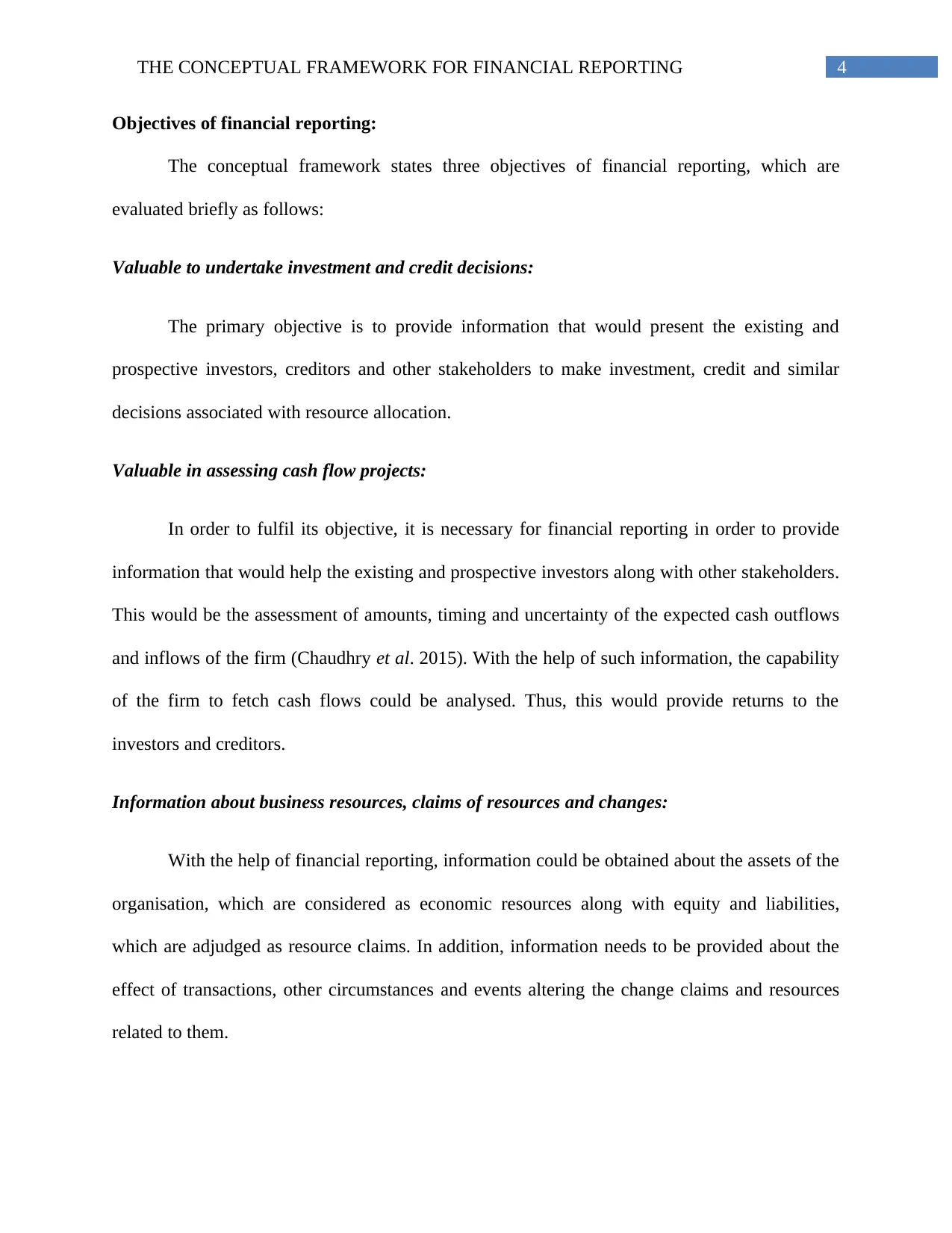
4THE CONCEPTUAL FRAMEWORK FOR FINANCIAL REPORTING
Objectives of financial reporting:
The conceptual framework states three objectives of financial reporting, which are
evaluated briefly as follows:
Valuable to undertake investment and credit decisions:
The primary objective is to provide information that would present the existing and
prospective investors, creditors and other stakeholders to make investment, credit and similar
decisions associated with resource allocation.
Valuable in assessing cash flow projects:
In order to fulfil its objective, it is necessary for financial reporting in order to provide
information that would help the existing and prospective investors along with other stakeholders.
This would be the assessment of amounts, timing and uncertainty of the expected cash outflows
and inflows of the firm (Chaudhry et al. 2015). With the help of such information, the capability
of the firm to fetch cash flows could be analysed. Thus, this would provide returns to the
investors and creditors.
Information about business resources, claims of resources and changes:
With the help of financial reporting, information could be obtained about the assets of the
organisation, which are considered as economic resources along with equity and liabilities,
which are adjudged as resource claims. In addition, information needs to be provided about the
effect of transactions, other circumstances and events altering the change claims and resources
related to them.
Objectives of financial reporting:
The conceptual framework states three objectives of financial reporting, which are
evaluated briefly as follows:
Valuable to undertake investment and credit decisions:
The primary objective is to provide information that would present the existing and
prospective investors, creditors and other stakeholders to make investment, credit and similar
decisions associated with resource allocation.
Valuable in assessing cash flow projects:
In order to fulfil its objective, it is necessary for financial reporting in order to provide
information that would help the existing and prospective investors along with other stakeholders.
This would be the assessment of amounts, timing and uncertainty of the expected cash outflows
and inflows of the firm (Chaudhry et al. 2015). With the help of such information, the capability
of the firm to fetch cash flows could be analysed. Thus, this would provide returns to the
investors and creditors.
Information about business resources, claims of resources and changes:
With the help of financial reporting, information could be obtained about the assets of the
organisation, which are considered as economic resources along with equity and liabilities,
which are adjudged as resource claims. In addition, information needs to be provided about the
effect of transactions, other circumstances and events altering the change claims and resources
related to them.
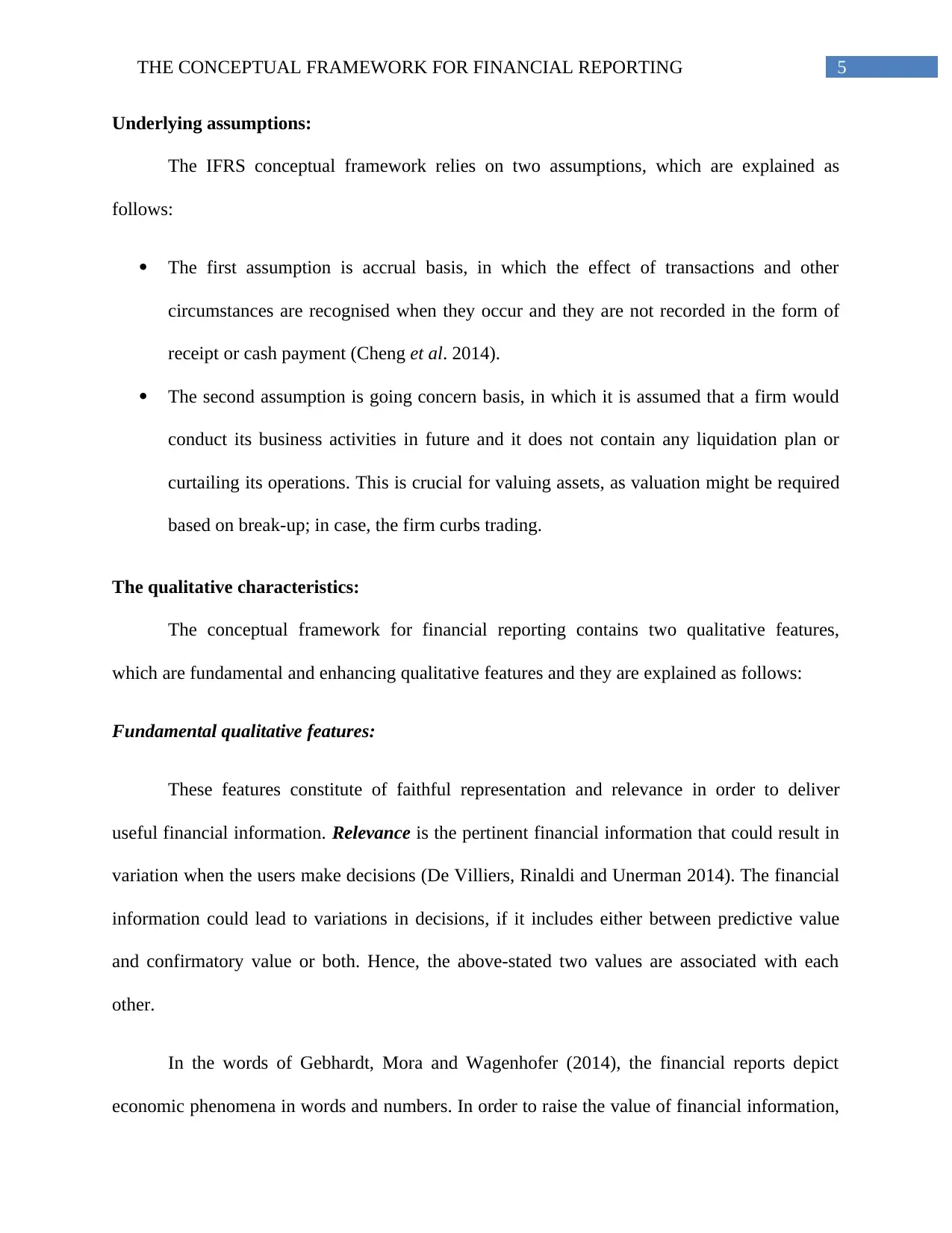
5THE CONCEPTUAL FRAMEWORK FOR FINANCIAL REPORTING
Underlying assumptions:
The IFRS conceptual framework relies on two assumptions, which are explained as
follows:
The first assumption is accrual basis, in which the effect of transactions and other
circumstances are recognised when they occur and they are not recorded in the form of
receipt or cash payment (Cheng et al. 2014).
The second assumption is going concern basis, in which it is assumed that a firm would
conduct its business activities in future and it does not contain any liquidation plan or
curtailing its operations. This is crucial for valuing assets, as valuation might be required
based on break-up; in case, the firm curbs trading.
The qualitative characteristics:
The conceptual framework for financial reporting contains two qualitative features,
which are fundamental and enhancing qualitative features and they are explained as follows:
Fundamental qualitative features:
These features constitute of faithful representation and relevance in order to deliver
useful financial information. Relevance is the pertinent financial information that could result in
variation when the users make decisions (De Villiers, Rinaldi and Unerman 2014). The financial
information could lead to variations in decisions, if it includes either between predictive value
and confirmatory value or both. Hence, the above-stated two values are associated with each
other.
In the words of Gebhardt, Mora and Wagenhofer (2014), the financial reports depict
economic phenomena in words and numbers. In order to raise the value of financial information,
Underlying assumptions:
The IFRS conceptual framework relies on two assumptions, which are explained as
follows:
The first assumption is accrual basis, in which the effect of transactions and other
circumstances are recognised when they occur and they are not recorded in the form of
receipt or cash payment (Cheng et al. 2014).
The second assumption is going concern basis, in which it is assumed that a firm would
conduct its business activities in future and it does not contain any liquidation plan or
curtailing its operations. This is crucial for valuing assets, as valuation might be required
based on break-up; in case, the firm curbs trading.
The qualitative characteristics:
The conceptual framework for financial reporting contains two qualitative features,
which are fundamental and enhancing qualitative features and they are explained as follows:
Fundamental qualitative features:
These features constitute of faithful representation and relevance in order to deliver
useful financial information. Relevance is the pertinent financial information that could result in
variation when the users make decisions (De Villiers, Rinaldi and Unerman 2014). The financial
information could lead to variations in decisions, if it includes either between predictive value
and confirmatory value or both. Hence, the above-stated two values are associated with each
other.
In the words of Gebhardt, Mora and Wagenhofer (2014), the financial reports depict
economic phenomena in words and numbers. In order to raise the value of financial information,
⊘ This is a preview!⊘
Do you want full access?
Subscribe today to unlock all pages.

Trusted by 1+ million students worldwide
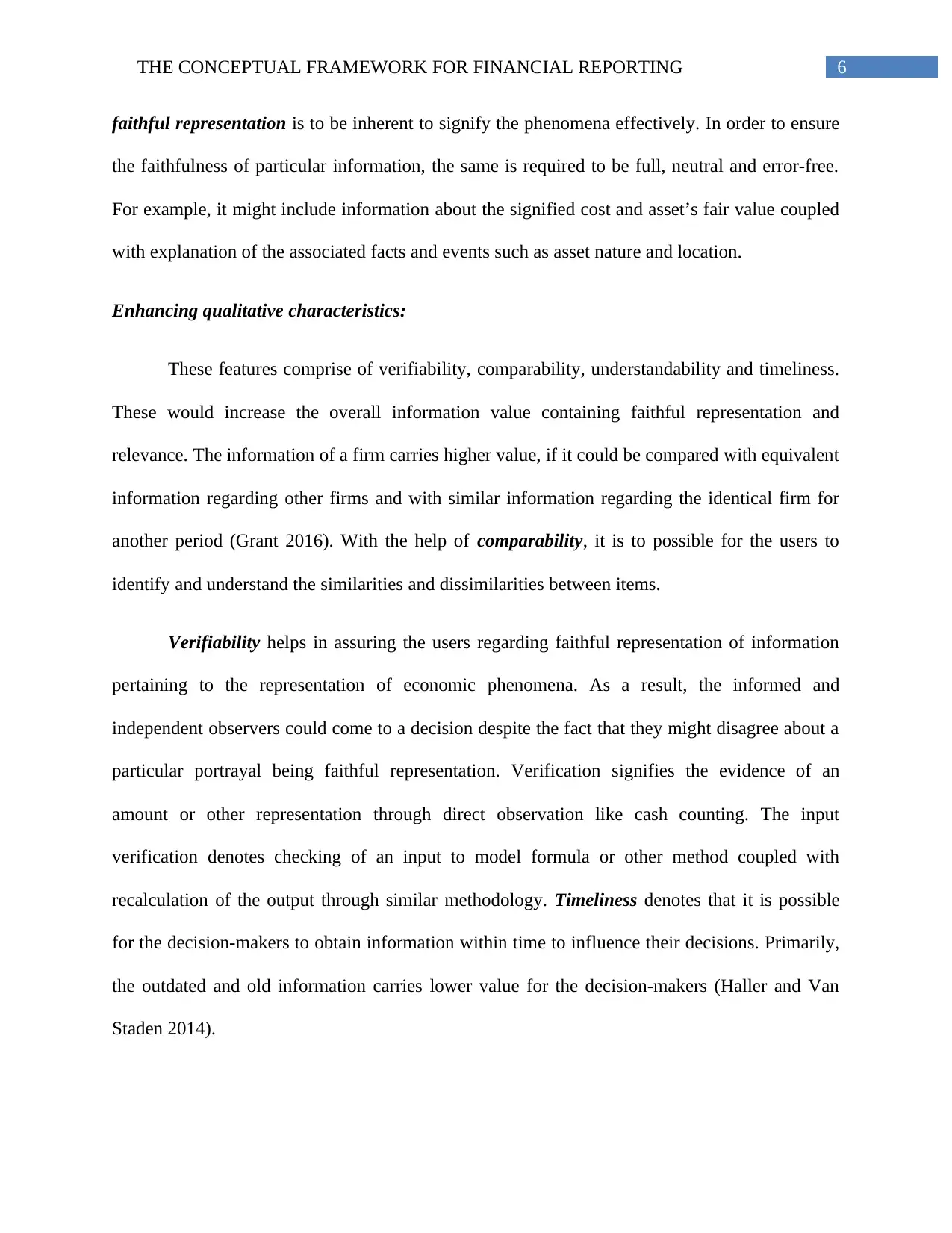
6THE CONCEPTUAL FRAMEWORK FOR FINANCIAL REPORTING
faithful representation is to be inherent to signify the phenomena effectively. In order to ensure
the faithfulness of particular information, the same is required to be full, neutral and error-free.
For example, it might include information about the signified cost and asset’s fair value coupled
with explanation of the associated facts and events such as asset nature and location.
Enhancing qualitative characteristics:
These features comprise of verifiability, comparability, understandability and timeliness.
These would increase the overall information value containing faithful representation and
relevance. The information of a firm carries higher value, if it could be compared with equivalent
information regarding other firms and with similar information regarding the identical firm for
another period (Grant 2016). With the help of comparability, it is to possible for the users to
identify and understand the similarities and dissimilarities between items.
Verifiability helps in assuring the users regarding faithful representation of information
pertaining to the representation of economic phenomena. As a result, the informed and
independent observers could come to a decision despite the fact that they might disagree about a
particular portrayal being faithful representation. Verification signifies the evidence of an
amount or other representation through direct observation like cash counting. The input
verification denotes checking of an input to model formula or other method coupled with
recalculation of the output through similar methodology. Timeliness denotes that it is possible
for the decision-makers to obtain information within time to influence their decisions. Primarily,
the outdated and old information carries lower value for the decision-makers (Haller and Van
Staden 2014).
faithful representation is to be inherent to signify the phenomena effectively. In order to ensure
the faithfulness of particular information, the same is required to be full, neutral and error-free.
For example, it might include information about the signified cost and asset’s fair value coupled
with explanation of the associated facts and events such as asset nature and location.
Enhancing qualitative characteristics:
These features comprise of verifiability, comparability, understandability and timeliness.
These would increase the overall information value containing faithful representation and
relevance. The information of a firm carries higher value, if it could be compared with equivalent
information regarding other firms and with similar information regarding the identical firm for
another period (Grant 2016). With the help of comparability, it is to possible for the users to
identify and understand the similarities and dissimilarities between items.
Verifiability helps in assuring the users regarding faithful representation of information
pertaining to the representation of economic phenomena. As a result, the informed and
independent observers could come to a decision despite the fact that they might disagree about a
particular portrayal being faithful representation. Verification signifies the evidence of an
amount or other representation through direct observation like cash counting. The input
verification denotes checking of an input to model formula or other method coupled with
recalculation of the output through similar methodology. Timeliness denotes that it is possible
for the decision-makers to obtain information within time to influence their decisions. Primarily,
the outdated and old information carries lower value for the decision-makers (Haller and Van
Staden 2014).
Paraphrase This Document
Need a fresh take? Get an instant paraphrase of this document with our AI Paraphraser
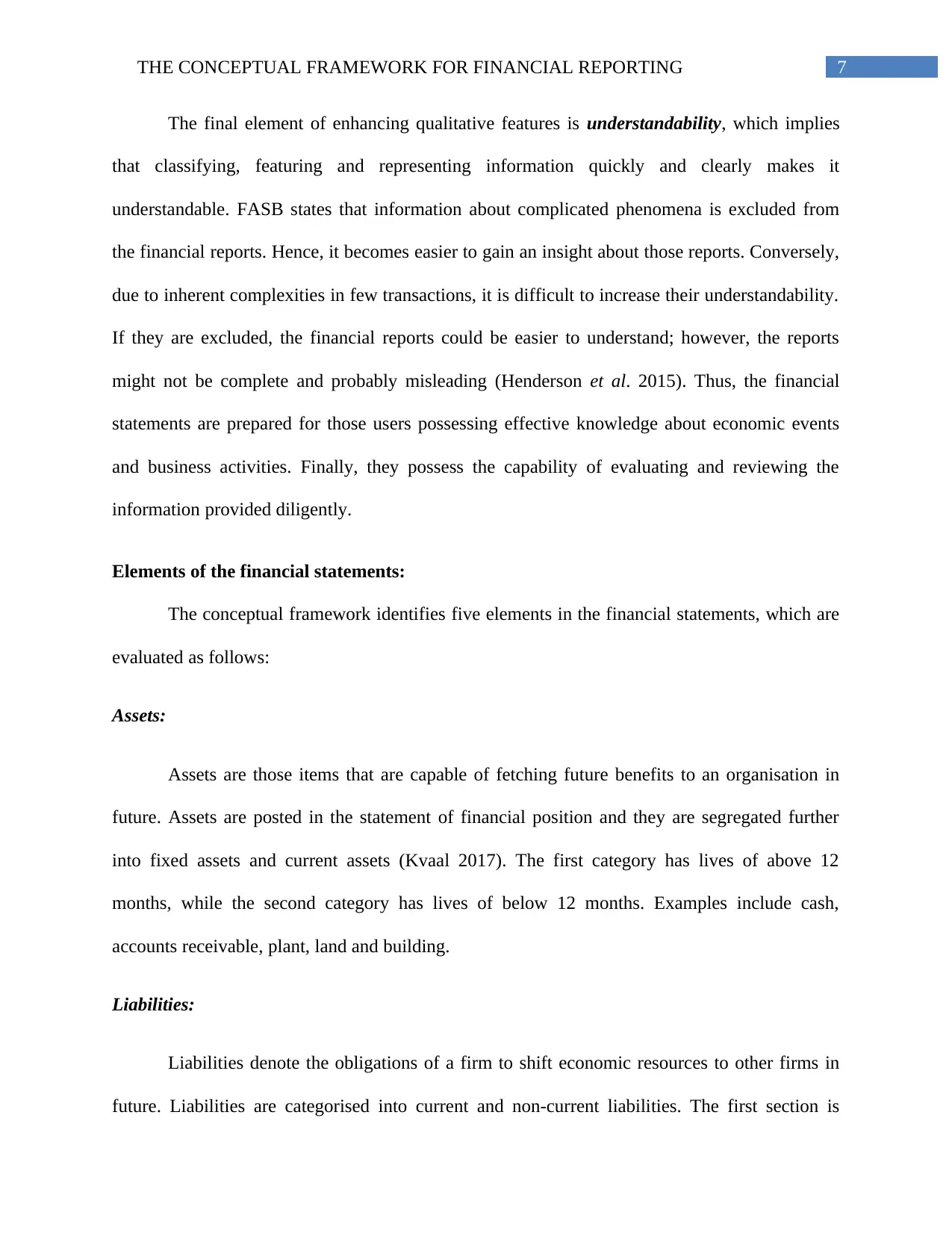
7THE CONCEPTUAL FRAMEWORK FOR FINANCIAL REPORTING
The final element of enhancing qualitative features is understandability, which implies
that classifying, featuring and representing information quickly and clearly makes it
understandable. FASB states that information about complicated phenomena is excluded from
the financial reports. Hence, it becomes easier to gain an insight about those reports. Conversely,
due to inherent complexities in few transactions, it is difficult to increase their understandability.
If they are excluded, the financial reports could be easier to understand; however, the reports
might not be complete and probably misleading (Henderson et al. 2015). Thus, the financial
statements are prepared for those users possessing effective knowledge about economic events
and business activities. Finally, they possess the capability of evaluating and reviewing the
information provided diligently.
Elements of the financial statements:
The conceptual framework identifies five elements in the financial statements, which are
evaluated as follows:
Assets:
Assets are those items that are capable of fetching future benefits to an organisation in
future. Assets are posted in the statement of financial position and they are segregated further
into fixed assets and current assets (Kvaal 2017). The first category has lives of above 12
months, while the second category has lives of below 12 months. Examples include cash,
accounts receivable, plant, land and building.
Liabilities:
Liabilities denote the obligations of a firm to shift economic resources to other firms in
future. Liabilities are categorised into current and non-current liabilities. The first section is
The final element of enhancing qualitative features is understandability, which implies
that classifying, featuring and representing information quickly and clearly makes it
understandable. FASB states that information about complicated phenomena is excluded from
the financial reports. Hence, it becomes easier to gain an insight about those reports. Conversely,
due to inherent complexities in few transactions, it is difficult to increase their understandability.
If they are excluded, the financial reports could be easier to understand; however, the reports
might not be complete and probably misleading (Henderson et al. 2015). Thus, the financial
statements are prepared for those users possessing effective knowledge about economic events
and business activities. Finally, they possess the capability of evaluating and reviewing the
information provided diligently.
Elements of the financial statements:
The conceptual framework identifies five elements in the financial statements, which are
evaluated as follows:
Assets:
Assets are those items that are capable of fetching future benefits to an organisation in
future. Assets are posted in the statement of financial position and they are segregated further
into fixed assets and current assets (Kvaal 2017). The first category has lives of above 12
months, while the second category has lives of below 12 months. Examples include cash,
accounts receivable, plant, land and building.
Liabilities:
Liabilities denote the obligations of a firm to shift economic resources to other firms in
future. Liabilities are categorised into current and non-current liabilities. The first section is
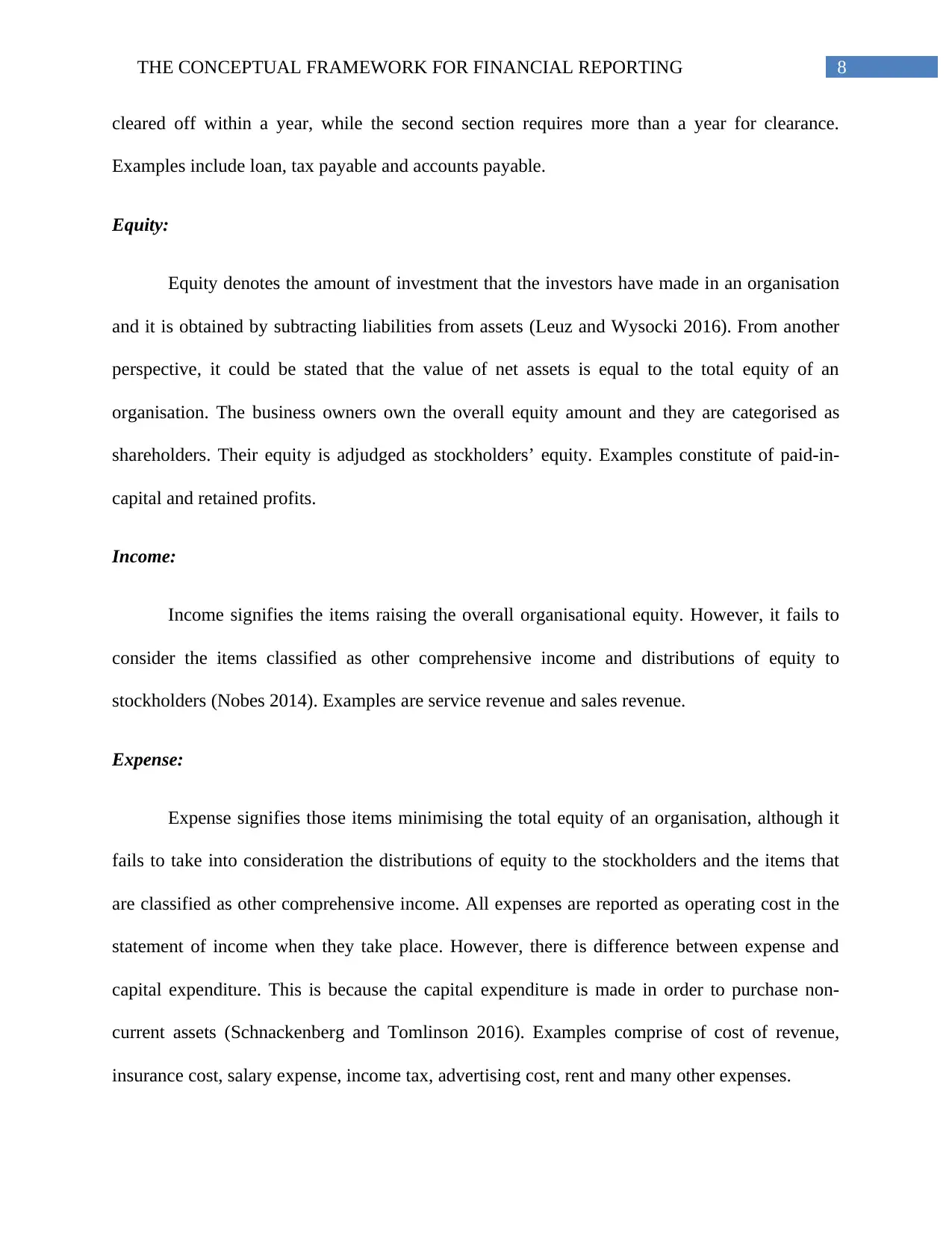
8THE CONCEPTUAL FRAMEWORK FOR FINANCIAL REPORTING
cleared off within a year, while the second section requires more than a year for clearance.
Examples include loan, tax payable and accounts payable.
Equity:
Equity denotes the amount of investment that the investors have made in an organisation
and it is obtained by subtracting liabilities from assets (Leuz and Wysocki 2016). From another
perspective, it could be stated that the value of net assets is equal to the total equity of an
organisation. The business owners own the overall equity amount and they are categorised as
shareholders. Their equity is adjudged as stockholders’ equity. Examples constitute of paid-in-
capital and retained profits.
Income:
Income signifies the items raising the overall organisational equity. However, it fails to
consider the items classified as other comprehensive income and distributions of equity to
stockholders (Nobes 2014). Examples are service revenue and sales revenue.
Expense:
Expense signifies those items minimising the total equity of an organisation, although it
fails to take into consideration the distributions of equity to the stockholders and the items that
are classified as other comprehensive income. All expenses are reported as operating cost in the
statement of income when they take place. However, there is difference between expense and
capital expenditure. This is because the capital expenditure is made in order to purchase non-
current assets (Schnackenberg and Tomlinson 2016). Examples comprise of cost of revenue,
insurance cost, salary expense, income tax, advertising cost, rent and many other expenses.
cleared off within a year, while the second section requires more than a year for clearance.
Examples include loan, tax payable and accounts payable.
Equity:
Equity denotes the amount of investment that the investors have made in an organisation
and it is obtained by subtracting liabilities from assets (Leuz and Wysocki 2016). From another
perspective, it could be stated that the value of net assets is equal to the total equity of an
organisation. The business owners own the overall equity amount and they are categorised as
shareholders. Their equity is adjudged as stockholders’ equity. Examples constitute of paid-in-
capital and retained profits.
Income:
Income signifies the items raising the overall organisational equity. However, it fails to
consider the items classified as other comprehensive income and distributions of equity to
stockholders (Nobes 2014). Examples are service revenue and sales revenue.
Expense:
Expense signifies those items minimising the total equity of an organisation, although it
fails to take into consideration the distributions of equity to the stockholders and the items that
are classified as other comprehensive income. All expenses are reported as operating cost in the
statement of income when they take place. However, there is difference between expense and
capital expenditure. This is because the capital expenditure is made in order to purchase non-
current assets (Schnackenberg and Tomlinson 2016). Examples comprise of cost of revenue,
insurance cost, salary expense, income tax, advertising cost, rent and many other expenses.
⊘ This is a preview!⊘
Do you want full access?
Subscribe today to unlock all pages.

Trusted by 1+ million students worldwide
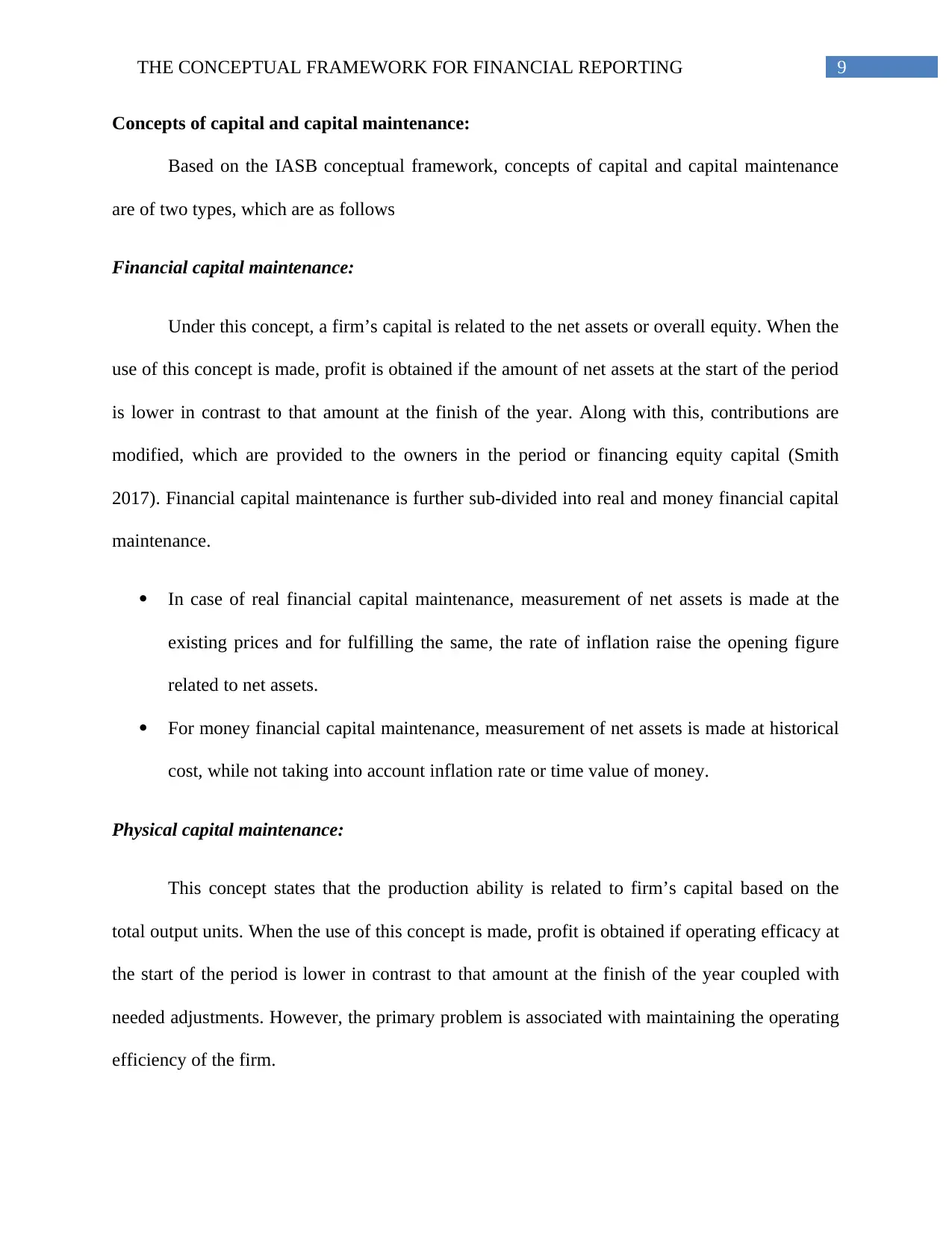
9THE CONCEPTUAL FRAMEWORK FOR FINANCIAL REPORTING
Concepts of capital and capital maintenance:
Based on the IASB conceptual framework, concepts of capital and capital maintenance
are of two types, which are as follows
Financial capital maintenance:
Under this concept, a firm’s capital is related to the net assets or overall equity. When the
use of this concept is made, profit is obtained if the amount of net assets at the start of the period
is lower in contrast to that amount at the finish of the year. Along with this, contributions are
modified, which are provided to the owners in the period or financing equity capital (Smith
2017). Financial capital maintenance is further sub-divided into real and money financial capital
maintenance.
In case of real financial capital maintenance, measurement of net assets is made at the
existing prices and for fulfilling the same, the rate of inflation raise the opening figure
related to net assets.
For money financial capital maintenance, measurement of net assets is made at historical
cost, while not taking into account inflation rate or time value of money.
Physical capital maintenance:
This concept states that the production ability is related to firm’s capital based on the
total output units. When the use of this concept is made, profit is obtained if operating efficacy at
the start of the period is lower in contrast to that amount at the finish of the year coupled with
needed adjustments. However, the primary problem is associated with maintaining the operating
efficiency of the firm.
Concepts of capital and capital maintenance:
Based on the IASB conceptual framework, concepts of capital and capital maintenance
are of two types, which are as follows
Financial capital maintenance:
Under this concept, a firm’s capital is related to the net assets or overall equity. When the
use of this concept is made, profit is obtained if the amount of net assets at the start of the period
is lower in contrast to that amount at the finish of the year. Along with this, contributions are
modified, which are provided to the owners in the period or financing equity capital (Smith
2017). Financial capital maintenance is further sub-divided into real and money financial capital
maintenance.
In case of real financial capital maintenance, measurement of net assets is made at the
existing prices and for fulfilling the same, the rate of inflation raise the opening figure
related to net assets.
For money financial capital maintenance, measurement of net assets is made at historical
cost, while not taking into account inflation rate or time value of money.
Physical capital maintenance:
This concept states that the production ability is related to firm’s capital based on the
total output units. When the use of this concept is made, profit is obtained if operating efficacy at
the start of the period is lower in contrast to that amount at the finish of the year coupled with
needed adjustments. However, the primary problem is associated with maintaining the operating
efficiency of the firm.
Paraphrase This Document
Need a fresh take? Get an instant paraphrase of this document with our AI Paraphraser
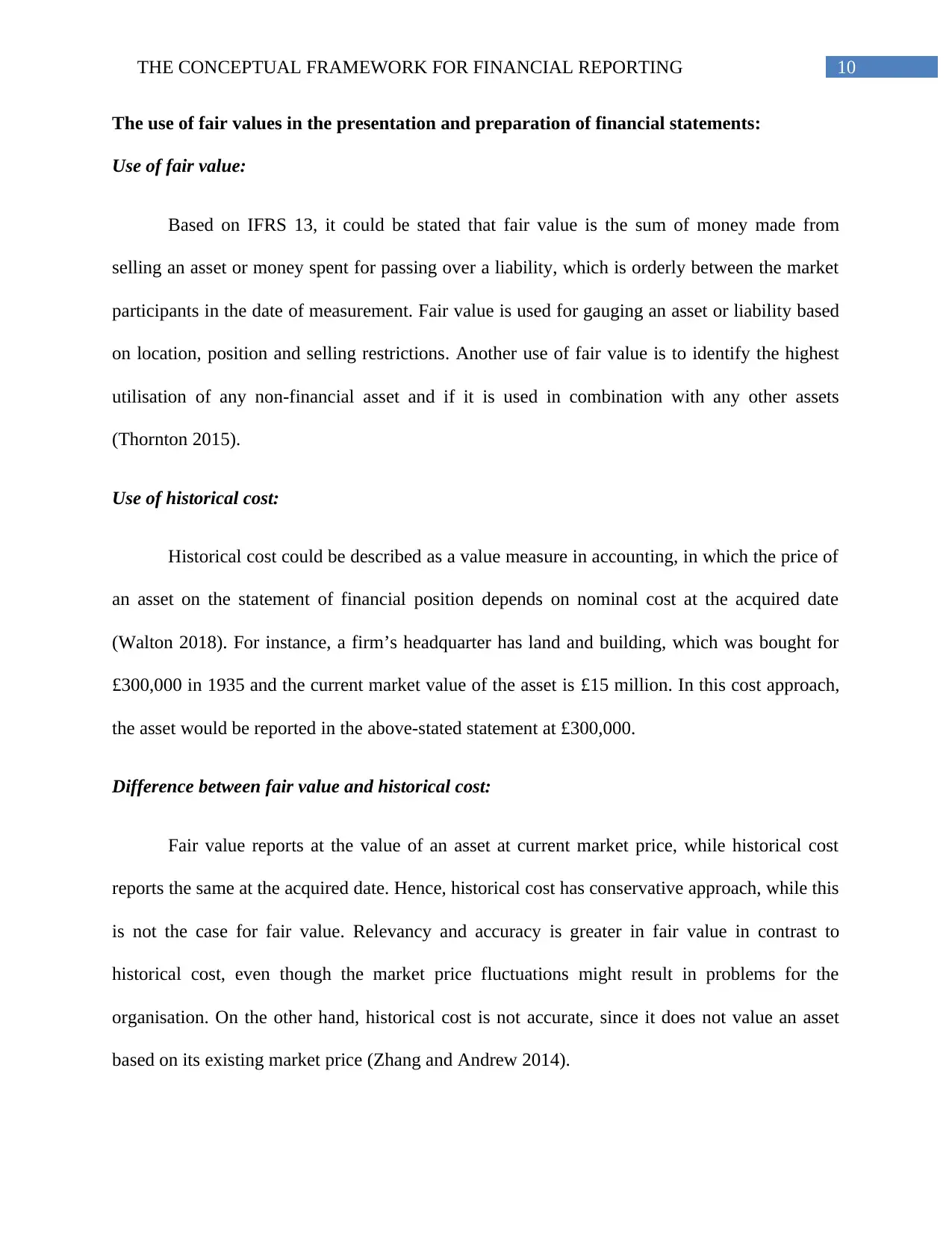
10THE CONCEPTUAL FRAMEWORK FOR FINANCIAL REPORTING
The use of fair values in the presentation and preparation of financial statements:
Use of fair value:
Based on IFRS 13, it could be stated that fair value is the sum of money made from
selling an asset or money spent for passing over a liability, which is orderly between the market
participants in the date of measurement. Fair value is used for gauging an asset or liability based
on location, position and selling restrictions. Another use of fair value is to identify the highest
utilisation of any non-financial asset and if it is used in combination with any other assets
(Thornton 2015).
Use of historical cost:
Historical cost could be described as a value measure in accounting, in which the price of
an asset on the statement of financial position depends on nominal cost at the acquired date
(Walton 2018). For instance, a firm’s headquarter has land and building, which was bought for
£300,000 in 1935 and the current market value of the asset is £15 million. In this cost approach,
the asset would be reported in the above-stated statement at £300,000.
Difference between fair value and historical cost:
Fair value reports at the value of an asset at current market price, while historical cost
reports the same at the acquired date. Hence, historical cost has conservative approach, while this
is not the case for fair value. Relevancy and accuracy is greater in fair value in contrast to
historical cost, even though the market price fluctuations might result in problems for the
organisation. On the other hand, historical cost is not accurate, since it does not value an asset
based on its existing market price (Zhang and Andrew 2014).
The use of fair values in the presentation and preparation of financial statements:
Use of fair value:
Based on IFRS 13, it could be stated that fair value is the sum of money made from
selling an asset or money spent for passing over a liability, which is orderly between the market
participants in the date of measurement. Fair value is used for gauging an asset or liability based
on location, position and selling restrictions. Another use of fair value is to identify the highest
utilisation of any non-financial asset and if it is used in combination with any other assets
(Thornton 2015).
Use of historical cost:
Historical cost could be described as a value measure in accounting, in which the price of
an asset on the statement of financial position depends on nominal cost at the acquired date
(Walton 2018). For instance, a firm’s headquarter has land and building, which was bought for
£300,000 in 1935 and the current market value of the asset is £15 million. In this cost approach,
the asset would be reported in the above-stated statement at £300,000.
Difference between fair value and historical cost:
Fair value reports at the value of an asset at current market price, while historical cost
reports the same at the acquired date. Hence, historical cost has conservative approach, while this
is not the case for fair value. Relevancy and accuracy is greater in fair value in contrast to
historical cost, even though the market price fluctuations might result in problems for the
organisation. On the other hand, historical cost is not accurate, since it does not value an asset
based on its existing market price (Zhang and Andrew 2014).
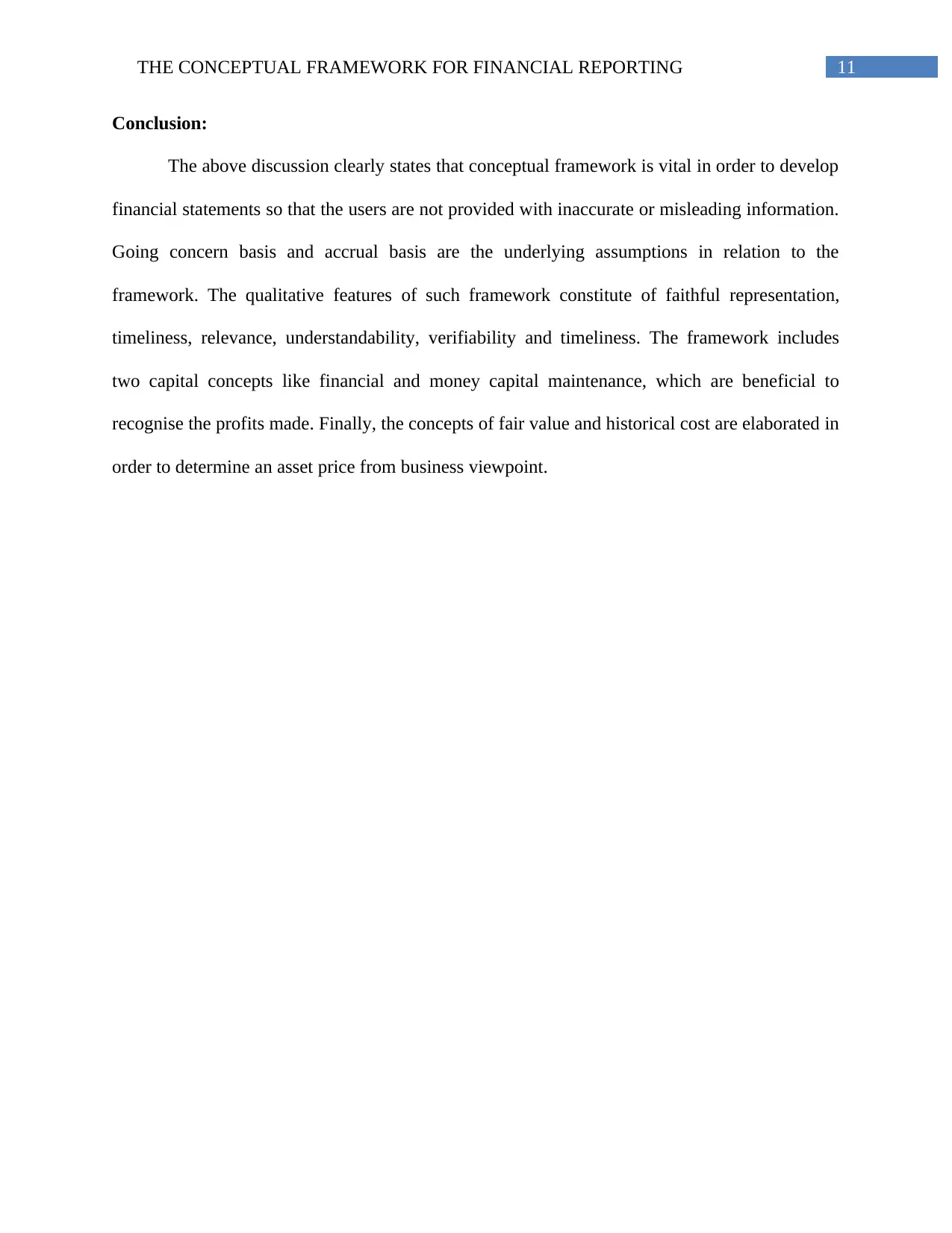
11THE CONCEPTUAL FRAMEWORK FOR FINANCIAL REPORTING
Conclusion:
The above discussion clearly states that conceptual framework is vital in order to develop
financial statements so that the users are not provided with inaccurate or misleading information.
Going concern basis and accrual basis are the underlying assumptions in relation to the
framework. The qualitative features of such framework constitute of faithful representation,
timeliness, relevance, understandability, verifiability and timeliness. The framework includes
two capital concepts like financial and money capital maintenance, which are beneficial to
recognise the profits made. Finally, the concepts of fair value and historical cost are elaborated in
order to determine an asset price from business viewpoint.
Conclusion:
The above discussion clearly states that conceptual framework is vital in order to develop
financial statements so that the users are not provided with inaccurate or misleading information.
Going concern basis and accrual basis are the underlying assumptions in relation to the
framework. The qualitative features of such framework constitute of faithful representation,
timeliness, relevance, understandability, verifiability and timeliness. The framework includes
two capital concepts like financial and money capital maintenance, which are beneficial to
recognise the profits made. Finally, the concepts of fair value and historical cost are elaborated in
order to determine an asset price from business viewpoint.
⊘ This is a preview!⊘
Do you want full access?
Subscribe today to unlock all pages.

Trusted by 1+ million students worldwide
1 out of 14
Related Documents
Your All-in-One AI-Powered Toolkit for Academic Success.
+13062052269
info@desklib.com
Available 24*7 on WhatsApp / Email
![[object Object]](/_next/static/media/star-bottom.7253800d.svg)
Unlock your academic potential
Copyright © 2020–2025 A2Z Services. All Rights Reserved. Developed and managed by ZUCOL.





